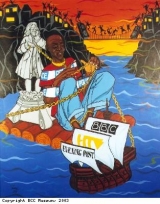Art
Black artists of African and African-Caribbean descent have been contributing to Bristol’s thriving art scene for many years. Some of their work is about the city itself, reflecting on the experiences they have faced or commenting on local issues. There are many black artists: those mentioned here are just some of many.
Dr. Eddie Chambers is a black British artist, curator, arts administrator, critic and writer based in Bristol. He was born in Wolverhampton in 1960. Chambers began organising exhibitions while still a student. Since then, he has curated a large number of exhibitions in Britain and abroad. Chambers has been dubbed one of Britain’s most controversial critics and curators. His writings have maintained his position as one of the most uncompromising voices of the art establishment.
In 1989, he founded The African and Asian Visual Artists Archive (AAVA,) which he co-ordinated until 1992. AAVA is a slide archive of contemporary visual art by artists of African and Asian descent. It has grown to become the most comprehensive slide archive of its kind in Britain since the post-war period. Eddie Chambers founded the archive with funding from the Arts Council and the Gulbenkian Foundation. It was in response to a severe lack of information about African and Asian artists and their contribution to the British and international arts scene. The archive is currently located at the University of East London, as a Research Centre led by David A Bailey and Sonia Boyce.
The AAVA collection holds a diverse and rich range of material available for research. The main objective of the archive is to enable the documentation and collection of the artistic developments by artists of African and Asian descent, which have occurred in Britain and abroad since the latter part of the twentieth century. The archive houses over 6,000 slides of artworks and exhibitions, as well as publications and videos about and by artists. There are over 200 individual artist folders, as well as curators, art historians, cultural critics and arts organisation files.
Helen Wilson is of African-Caribbean descent and is from Easton in Bristol. Helen Wilson’s journey to Rwanda, in Central Africa, inspired a moving exhibition Making Sense: A Rwandan Story (at the Bristol City Museum & Art Gallery in Autumn 2003). It portrayed the aftermath of the genocide in Rwanda through paintings, poems and music. In his introduction to the exhibition catalogue, the distinguished writer and journalist Fergal Keane wrote: “To gaze into such a darkness as Helen Wilson has done takes a courage which most artists will never be called on to display. Her aesthetic sensibility is acute and she is a truly gifted artist. But the greatest gift she brings to these paintings is humanity. I have looked at so many images from Rwanda that I truly believed I would see nothing that could surprise me. Nor did I expect to see images which would offer some hope amid the terrible despair wrought by Genocide”.
Born and based in Bristol, artist Tony Forbes works with organisations such as Right Track, which works with young disadvantaged people. He graduated from the illustration course at the University of the West of England in 1998. In 1999 Tony was commissioned to do a painting by Bristol City Museum & Art Gallery for the exhibition ‘A Respectable Trade? Bristol and Transatlantic Slavery’. As the statement below explains, Tony’s painting was a reflection of his experiences in Bristol as a young black man:
“I really love this city. I was born in St Paul’s and grew up on a white council estate called Southmead. There are things about Bristol I’m proud of, but…
The Festival of the Sea in 1996 was an example of how some of the institutions that run the city have failed to understand the people of Bristol. They celebrated Bristol’s maritime history and ignored slavery. The centrepiece was the launch of the replica of John Cabot’s ship, the Matthew. His voyage in 1497 opened the way to the genocide of Native Americans and colonisation.
This festival, encouraged by the Council, funded by big business and hyped by our media, was a slap in the face to the black community and an insult to the intelligence and sensitivity of many Bristolians. It was the weekend that Bristol broke my heart.
The figure on the raft is a portrayal of the way I feel about how I have been treated by authority. The people I grew up with in Southmead have treated me as an equal regardless of colour: it’s all about respect. In the 1980s, Margaret Thatcher increased the powers of the police. The new sus laws were used against the white working-class as well as ethnic minorities. Black and white kids from the estates were picked up, and beaten up in the back of police vans or taken miles away from home and dumped – some policemen even used to defecate in your shoes and then tell you to walk home.
The Suspension Bridge is about Clifton. Clifton has all the privileges. The people I painted on the bridge are the ones who control and influence the city. I feel they don’t give a damn about what happens to anyone else.
When I look at Colston’s statue I just think of dead children. I can handle the fact that the statue is there, but there’s nothing to say he was a slave trader. It was erected in 1895 by the people of Bristol. Over a century later, isn’t it time for Bristolians to express their feelings about today’s multi-cultural society?
What I am trying to show in the picture are some of the things I don’t want to see happening to the next generation of kids, black or white. We have to live together.”



